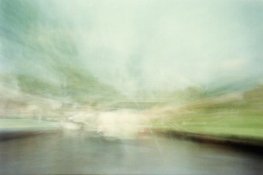This was an interesting read, like the other articles on your blog.
As you said: "
So, we shall free ourselves of the technical aspects of the customary understanding of depth of field, and let’s focus on the aesthetic." That's a good way to find a new approach to ones photography.
I like your technique as well: "
Want a pinhole photo of an object that really pops? Put that object in motion and lock the camera to that motion"
Here are some of my examples to go along with your article:
This is my WPPD-2015 contribution. PinHolga 6x6, Fuji NPC 160 (expired 2004), exposure 10 sec.
I followed the truck on the highway for 280 meters in 10 seconds (about 100 kmh).
And this technique is also useful for landscapes:
I made these images with my pinhole camera (a rebuild Gevabox 6x9). The exposures were handheld (no tripod) for 40 seconds on Konica PRO 400 roll film. It's what I might call "controlled pinhole blur".
The image on the left was made from the shore overlooking a wide lake, as part of a series of pinhole landscapes. I was pleasantly surprised how it turned out. The image on the right was made standing on a boat in a canal in the historical town of
Giethoorn.
Bert from Holland
http://thetoadmen.blogspot.nl



















